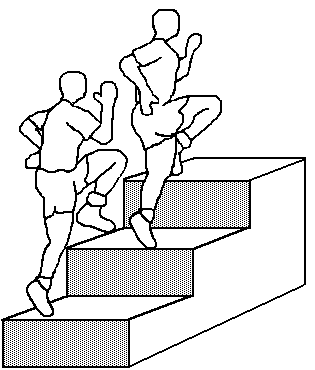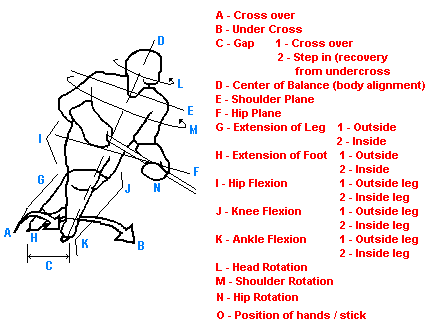
OFF-ICE Skating Specific Training
There is an incredible amount of information circulating out there on what is the best off-ice sport specific training program that would best develop one's skating potential. Lately these programs have been more "FAD" specific than sport specific. For example, we have heard that "roller blade" training was the best, then players found that certain skating fundamentals deteriorated so roller-training was dropped. Explosive training or plyometrics was the next training fad, then players found that stress fractures and muscles pulls were the result. Apparently CORE and balance training is the new FAD. And this year, from the information circulating out there, Bungee and harness training is going to be the new craze.
What I have found is that each program warrants merit. Roller blade training has its place as does plyometrics and Core/Balance training and, certainly bungee / harness training has it's application. However, I have found that any player with a technical deficiency in their shooting, stick handling or skating, their "problem" is even more magnified once their training regiment has been completed. Players do become faster and quicker and stronger but are still technically problematic. HOW TO CHANGE THIS the becomes the question.
An off-ice training program must duplicate as EXACTLY as possible the exact bio-mechanical sport specific technique. In order to do this we must first understand a player's skill mechanics before embarking on a summer training regiment. I often get players that come to me asking for a training program that will make them faster. Our exchange kind of goes like the following:
"I would like some help on improving my speed, coach says that I need to be faster"
"What type of speed are you talking about, faster where....?"
"I don't know...getting down the ice I guess"
"So he never really explained to you what your real problem area was?"
"Well he said that I needed to improve my stride"
"Did he say what was wrong with your stride...choppy, slow..?"
"Not really, just said that there was something wrong with it?"
"Okay, so he wants you to improve your stride which should make you faster down the length of the ice."
"I guess so..is there a work out program that I could use to make me faster"
"Do you mean on ice?
"No..you know, in the gym..coach said something about plyometrics or something"
"So...as I understand it. You would like me to put you on a weight training program that would increase your game speed".
"Yeah if you wouldn't mind"
And that is more or less how is goes. There is no real quantitative data saying how fast this player really is and specifically, how fast he/she needs to be. SO, without real "bench-marks", how does this player begin to goal-set on a result that would make his coach happy. Does he have to come back faster than another player on the team, another player on another team?
What I have found is that most of the player suffer from technical problems. However, it is important to understand that maybe this player does not really want to rebuild his stride but rather just wants to make his "imperfect" stride stronger. Since technical problems can be one of or a combination of three separate parts; "shooting, stick handling AND skating" the rebuilding and strengthening problem can be quite complex. [Why three parts? Hand position or more importantly, hand separation on the stick determines hip and knee angle / flexion. If a player has weaker lower quad (thigh) development, then the player will depend on the gluteus muscles (butt) to handle the stress and so on. Now, while off-ice quad, glut and calve training will improve]. For a player wishing to JUST improve his speed, the only consideration is the cross-training effect; "how much transference actually takes place relative to training time and output".
This page or combination of pages is to try to maximize transference thus maximizing training time and effort. I will provide animations / pictures as often as possible so as to clarify actual training technique relative to MSEs (micro-skill elements).
What I will endeavor to do is to put together exercises and place them on this page that specifically target the MSEs of a skill set (the knee action on recovery after extension on the crossover for example). This page will be quite extensive so please be patient with the loading and of course as the information becomes more in depth I will isolate particular skating elements on the index page so that you can move directly to the desired skill.
THE CROSSOVER:

As we can see in the above diagram there are many micro-components to the actual crossover skill set. Breaking down the following definitions would perhaps be a good place to start:
A - The CROSS-OVER.
Apply named. This is the action of bringing the outside foot from an inside edge position over the inside foot to a outside edge position. This skill element has several important points that must be considered.
1 - Heel gap utilization of the space over the foot. This action determines ultimately the body center of balance. SEE C1 Below

2 - Action of the foot or extension of the foot as the outside skate passes over the inside foot and how the skate makes contact with the ice surface.. This action plays an important role in not only a player's center of balance but angle of thrust and leg extension type.
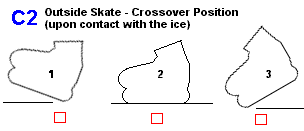
3 - Position of the foot upon contact with the ice surface (toe, flat blade, heel) as explained above ultimately determines a player's center of balance. Shown in the diagram below is the foot/blade action after contact. Soft foot is the flexing of the ankle, the stiff foot or slide set method is where the ankle does not flex but is brought into position by slipping forward and the stiff foot step describes the placing of the blade in a "flat" position on the ice, again with no flexing of the ankle.

B - HIP PLANE
1 - This action of the hips during the crossover or variation of the parallel plane varies slightly depending on the type of crossovers used. There are several basic types of forward crossovers; Static to motion Acceleration, curve acceleration (already in motion through a tight corner and picking up speed), maintenance or curvature speed (slight reach in with more dynamics on the pulling action towards and pushing through under the body) as well as long game crossovers (dynamic acceleration over a wide radius). Control of hip plane becomes critical during each one of these skill elements.
2 - Hip extension. This is the actual movement of the inside hip up and down (recovery and extension) during the actual thrusting and recovery phase of the the inside leg.
C - GAP
1 - The word GAP describes the distance between the inside foot and the outside foot upon placement of the inside skate / outside edge on recovery and placement. This gap will vary depending on the type of crossover used as explained above. To wide a gap places the thrusting angle in too upright a position forcing a player to exit to height to early during crossovers leaving no power on extension. In diagram D, the player must concern him/herself with two basic recovery positions; (1) forward to back or vertical placement shown in D, and left to right (lateral) shown in E2a and E2b.
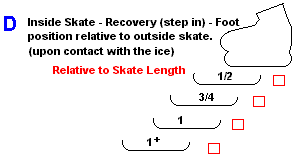
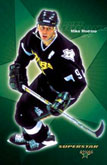
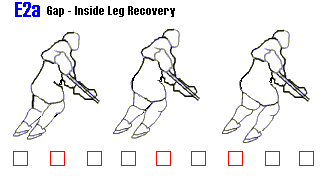
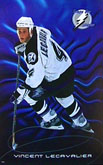

D - CENTER OF BALANCE
1 - Center of Balance describes the distribution of weight through the body from head to toe and the subsequent effect on balance, stability, mobility and generation of power and speed.
A - Center of balance specific to each cross-over technique explained above.
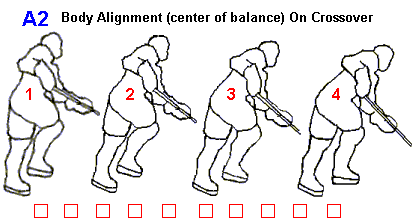
E - SHOULDER ALIGNMENT (PLANE)
1 - Shoulder position relative to skating plane effects dramatically ones ability to accelerate, maintain speed, be agile as well as exit and / or perform evasive maneuvers (out of or during the cross-over). A player's ability to control alignment comes from either the torso / hips or from the shoulder / traps themselves.
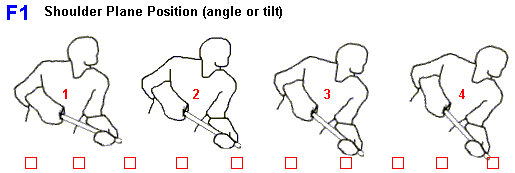


F - HIP PLANE
1 - The Hip Plane controls the degree of step in or Gap as explained in "C". This effect on the recover position of the inside foot or outside edge can be very dramatic.
G - EXTENSION OF LEG
1 - This is the most trained sport specific fundamental in the GYM. Players perform squats, leg extensions, lunges, leg presses, jumps, etc so as to maximize strength/speed in the thigh and gluteal muscles with the idea that if these muscles are stronger then they should be able to propel the body forward faster and more powerfully. Without getting too complicated here, this in most cases is correct. Studies have shown that there is a correlation between a player's speed and a player's thigh strength and size. In the studies that I have done and have explained in the RESEARCH page, an elite skating player performing crossovers could exert up to 2.6 times his body weight per leg. Based on physics and bio-mechanics in then becomes easy to assume that greater leg strength is answer. What I am saying is that it is ONE of the answers.
2 - While the leg does extend, there are two distinct differences during the crossover that a player has to take into consideration when cross-training. The outside leg extends away from the body and the inside leg extends through under the body. As well, adduction (pulling towards the body) of the inside leg and abduction (away from the body) of the outside leg occurs during crossovers as well.

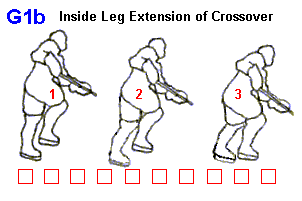

H - Extension of Foot
Both of the diagrams G2a/b shown below desribe the position of the foot at the end of extension whether inside or outside leg on thrust.
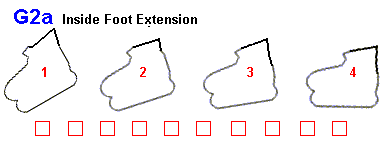

I - Hip Flexion (A)
The diagram below demonstrate the position of the upper body relative to the thighs. This position or hip flexion dramatically effects thrust/extension effectiveness both the inside or outside leg.
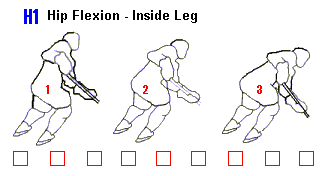

1 - Hip Flexion (B) The following diagrams represent Hip Flexion but only specific to the knee action on recovery from outside leg extended position. In the diagram above we are concern with the upper body / thigh angle which moves the players center of balance ahead of his feet and knees creating poor extension (thrust) effectiveness. In (1), the player has relaxed the foot and the knee allowing the foot/skate the remain close to the body maintaining a strong center of balance allowing for maximum cadence and thrust.
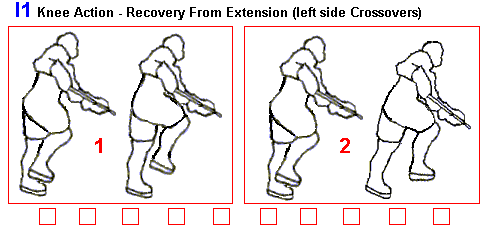
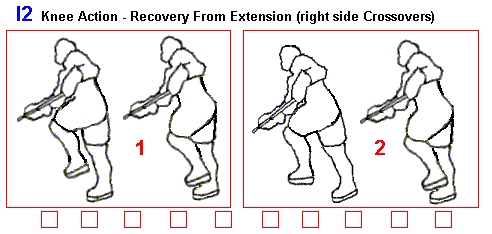
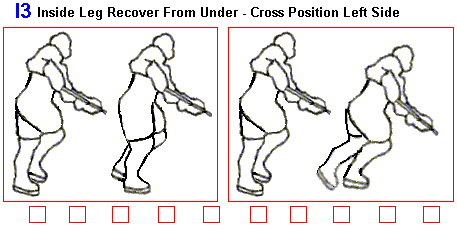
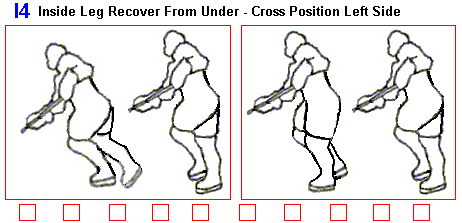
J - Knee Flexion
This diagram demonstrates the position of the knee on the inside or outside leg prior to extension. This position could alternately be called the recover position of either the step in or the crossover upon contact with the ice surface.
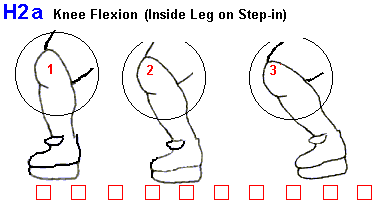


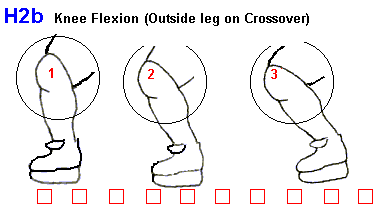
K - Ankle Flexion
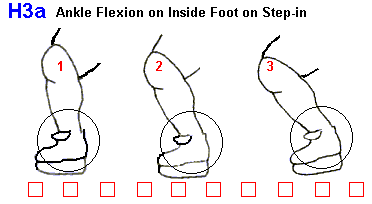
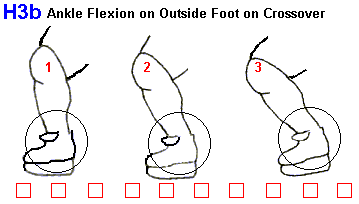
L - Head Rotation Left Side Crossovers



L - Head Rotation Right Side Crossovers

M - Shoulder Rotation - Left Side Crossovers



M - Shoulder Rotation - Right Side Crossovers
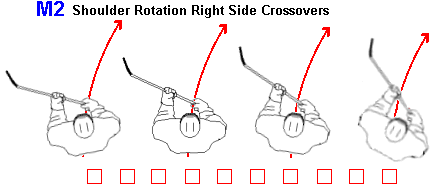
N - Hip Rotation. Hip rotation describes the action of rotating over the inside hip/leg so that the inside leg is rotated inwards. This rotation helps to place the skate in an outside edge power position so as to maximize thrust on the under cross when extending the leg. In drawing (1) the toe of the skate is pointing up ice, (2) the toe of the skate is placed on the edge of the circle in a neutral position and (3) the toe is pointed down ice which is the best position, placing the skate in a power / outside edge position.
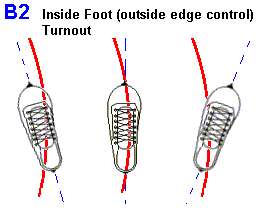
In the diagrams below, I have shown variations of outside skate problems when inside skate/outside edge are placed in either of 3 positions (up-ice, neutral ice, down ice).
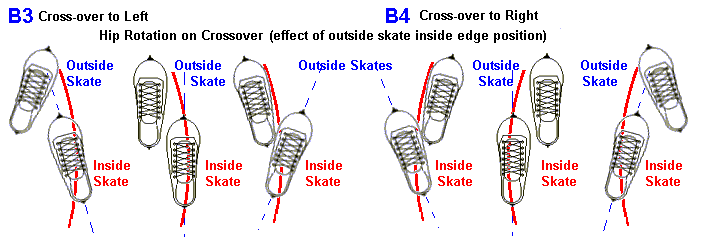
I have put some of the following pictures on this page so that one can see the cross-training effect relative to Skating skill. I will explain more in depth later.
Off-Ice training exercise 1 - Hip flexion (knee action, relaxed foot position toe down, soft foot on touch down - toe to flexed ankle to flat foot). Marching left to right.

Off-Ice training exercise 2 - Single Leg Skipping (thrust off of one leg extending hip, knee and ankle while flexing over hip and knee bringing knee up as high as you can as shown). Alternate left and right jumping lightly at first, then explosively as strength and skill develops.
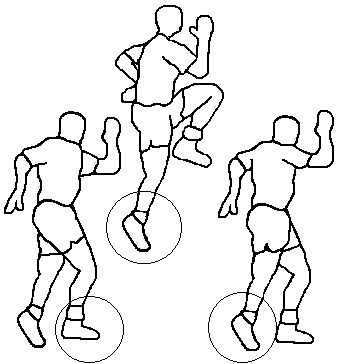
Off-Ice Training exercise 4 - Side Stair Run (perform sideways as shown keeping knee action high on both inside and outside legs. Keep feet soft
